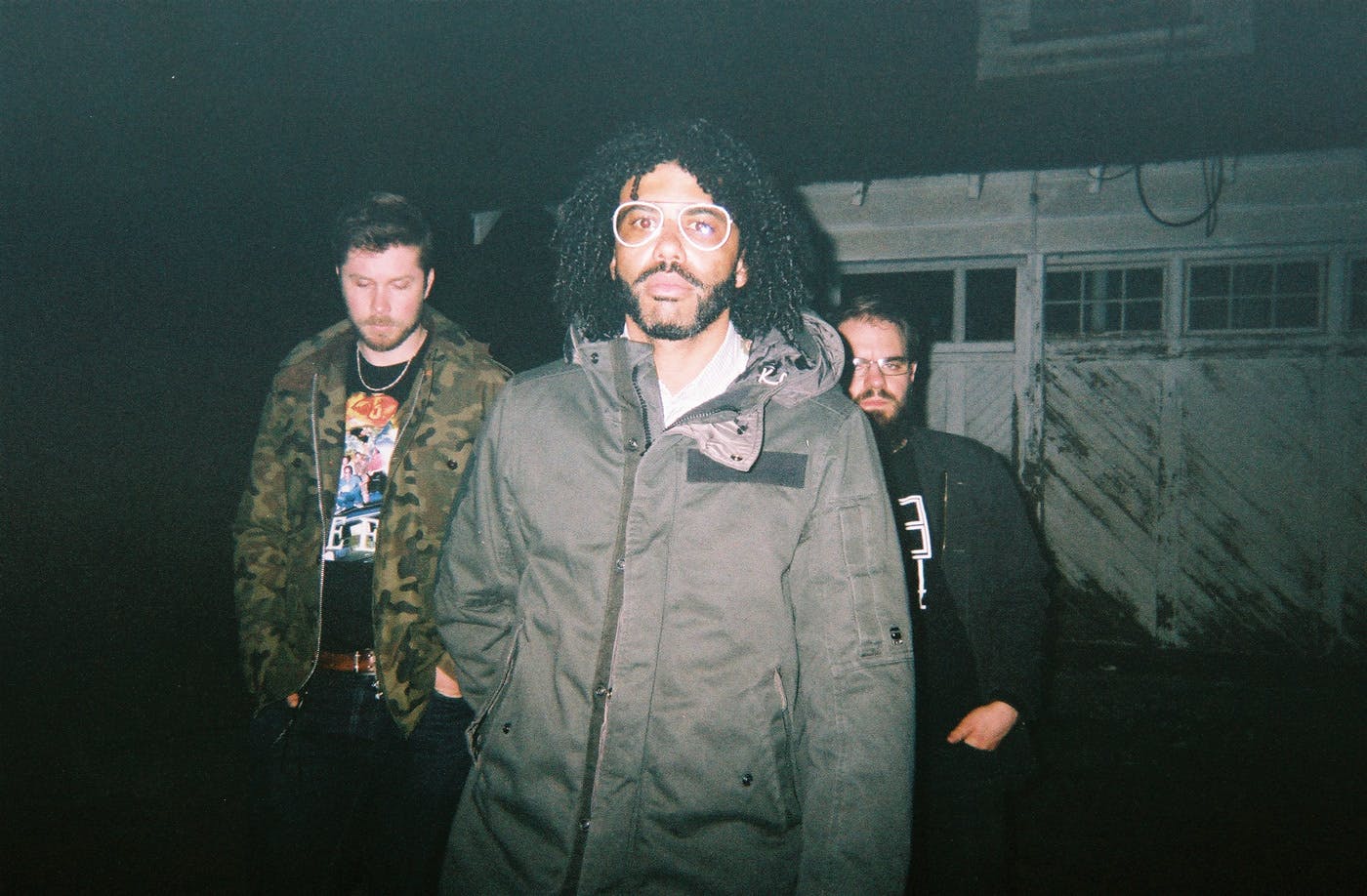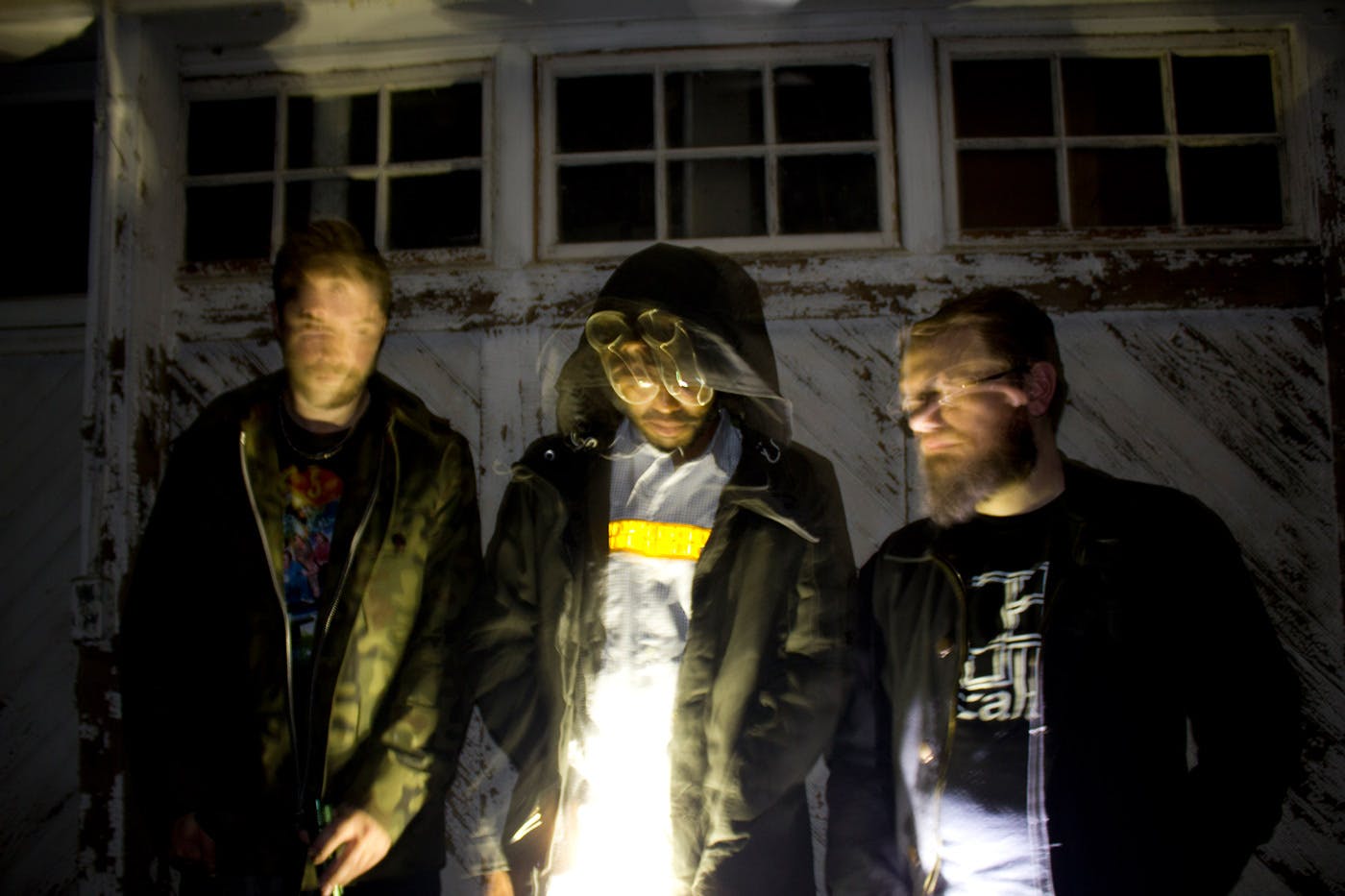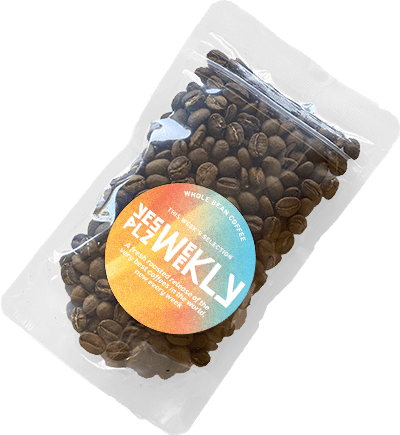SHARE
Interview with horrorcore hip-hop geniuses Clipping.

The L.A.-based experimental hip hop trio’s new album melds fiction and film
|
Music
photographed by Cristina Bercovitz
The members of the L.A. experimental hip-hop group Clipping approach their music as they would a piece of cinema, and that’s not by coincidence. The members of the trio—rapper Daveed Diggs and producers William “Bill” Hutson and Jonathon Snipes—have fruitful careers in various sects of the visual arts industry. And on their third full-length, There Existed An Addiction to Blood, they melded many of their artistic specialties and passions outside of Clipping to make their bizarrely twisted version of a horrorcore album.
Diggs was an original cast member of the world-renowned musical Hamilton, in which he played the roles of Marquis De Lafayette and Thomas Jefferson. He departed from the Broadway production in 2016 (upon winning both a Grammy and a Tony for his performances) and assumed roles in various TV shows such as Black-ish and The Get Down before eventually writing, producing and starring in the 2018 film Blindspotting. Snipes has a multitude of professional practices (film and theater scoring, sound design, and field recording) and has found particular success composing soundtracks for horror films. Hutson, a talented noise musician, is currently writing for a TV show he sold while also working on a couple screenplays (non-disclosure contracts forbid him from revealing any specifics).
Clipping began in 2009 as an extremely specific side-project for the three creatives. Their early releases, namely their 2013 mixtape Midcity, were constructed within a rigid set of self-imposed guidelines. During a phone call with Yes Plz from their homebase in Los Angeles, Snipes and Hutson explain that their initial vision for the band was almost an ode to Process Music—the 1960s compositional movement of creating music in an incredibly calculative, scientific manner.

“We made a list of constraints and a list of rules, and a list of goals for a track,” Snipes explains. “And when we checked all the boxes we were like, “Well, it’s done.” And I remember very clearly that when we first started making this music we didn’t know if it was working or not, we just knew that we had checked all the boxes that we set up for ourselves.”
Their first few restrictions were: no recognizable drum sounds, no melody, and no harmony. However, because they were making hip-hop beats, rhythm and structure were required.
“We didn’t stop working on a song because it was done or good,” Hutson says. “We didn’t know if it was good or if it worked at all. We would stop because we were like, ‘Well, the things we said we wanted to do, we did those. And now the track exists, so I guess it’s done. But I don’t know if we like it or if anyone else ever will.”
People did in fact like it, though, and the group ended up signing to Sub Pop Records in 2013. However, once they were signed to the label and the band was becoming their main project, not a weirdo side venture, they felt they needed to remove the constraints in order to satiate their shared hunger for theatrical art.
Their 2016 album Splendor & Misery, an afrofuturist concept album about an enslaved individual on a cargo ship travelling through outer space, was a full-on dive into cinematic grandiosity. The record ended up being nominated for a Hugo Award for “Best Dramatic Presentation, Short Form”, which is only the second time a musical album has ever been considered for that category. Their narrative talents were recognized again by an author named Rivers Solomon, who wrote an entire novella based on Clipping’s 2017 single “The Deep,” a song the band created for an episode of NPR’s This American Life.
“Our song was already so indebted to the work of Drexciya, the Detroit electro group, that we felt like we were already making a take on our response to something that already existed,” Snipes says. “And so reading Rivers’ response, to us, just feels like a natural progression… All of these are just a conversation in response to each other. It’s not about interpreting one thing for a different medium, it’s about each piece just being the next thing in the chain.”
In that sense, There Existed An Addiction to Blood is Clipping’s response to the horrorcore hip-hop of Brotha Lynch Hung and early Three 6 Mafia, which they’ve always loved and knew they wanted to pay homage to. But also, as horror film and literature lifers, their long-awaited opportunity to make a musical anthology of horror stories in the vein of the blaxploitation flicks of the 1970s—which they view as distinctly political, as Clipping has always been. The title of the album is taken from the 1973 film Ganja & Hess, an avant-garde horror film about black vampires that’s sampled in the centerpiece of the album, “Blood of the Fang.”
“It’s a lot of things I’m attracted to and interested in in noise, and metal, and extreme music,” Hutson says. “Which is, like, a very vocal hard-left, anti-racist politics. But that’s handled kind of irresponsibly and violently, in a way that would be frowned upon by non-anarchists, I guess.”
The album is arguably the most pictorial and virtuosic the band has ever been, featuring some of their most melodic and noisiest beats, and some of Diggs’ most frenetic verses. Hutson and Snipes talked in-depth about how their pursuits outside of hip-hop influence Clipping, their interest in the horrorcore genre, and the creative process for some of the standout tracks on There Existed An Addiction to Blood. Our conversation has been condensed for clarity:
You’re all working in the visual arts field outside of Clipping. How do your experiences in that realm influence what you’re doing in Clipping itself?
Hutson: Jonathon will get an idea that some other project is not interested in and won’t let him do, that he’ll bring to Clipping and then we’ll do it. . .Clipping is where we get to do all the things that we think of in our normal lives, and apply those things to a thing that we know the three of us want to do and trust each other in. And [where we] want to do weirder, more out-there ideas that maybe not everyone else wants.
Snipes: Even the thermos that we sampled for “Work Work” [off of 2014’s CLPPNG] for the main rhythm was an opening night gift from a play I sound-designed. But I used to really compartmentalize and think of all of my different works and practices as separate, and Clipping was the thing that made me see how connected they all are. Like, this technique that I learned from doing a play could somehow be applied to making a rap song.
Hutson: At least a couple songs on this new album started as movie pitches that we turned into songs. That were, like, ideas I had for screenplays.

Was “Nothing Is Safe” one of those? It definitely sounds like it could’ve been used for a soundtrack.
Hutson: Yeah, it was.
Snipes: It happens very rarely, but occasionally a complete piece of music will just kind of pop into my head and every part of it will be immediately clear and it will stay in my head for months and I won’t be able to get rid of it. “Nothing Is Safe” was one of those. And I just thought I would use it one day for a film score. And we were talking about the idea of […] making a really synthy, John Carpenter, 80’s horror rap song. And I said, “Well I have this thing stuck in my head.”
Hutson: We listened through all the John Carpenter scores in like 20 minutes, just skipping through to make sure that melody wasn’t really from one of the movies. Jonathon was a little nervous, he was like, “It’s so in my head that I think I might’ve actually heard it before.”
Tell me about the making of the song “Run For Your Life,” which has all sorts of different beats and instrumental moves going on.
Hutson: That was two different ideas stuck together. I wanted a song with La Chat [of Three 6 Mafia] because she’s sort of a horrorcore icon. She was always the scariest, toughest member of Three 6 in those days. And I had this idea of her verse that was basically her hunting down someone, driving through the streets chasing someone who’s running from her. And Jonathon had had this idea years and years ago that we had been talking about forever that would be Daveed rapping on a street corner, and every car that goes by would be playing a different beat that was all synced up.
Snipes: This is a perfect example of me having a crazy and goofy idea that Bill reigns in and makes really specific. In my version of this, each car is listening to a reggaeton station or a classical station or talk radio, totally different genre mashups. I have ideas that are centrally novelty songs that Bill somehow manages to make into something that’s smart and specific.
I’d love to know your process behind the song “Piano Burning,” an 18-minute recording of a piano literally burning. How does that fit into the context of the album thematically and musically?
Hutson: It’s a piece of concert music that we just performed. It’s actually composed by a woman Annea Lockwood, it was composed in 1968 and first performed them. And it’s a short set of instructions on how to burn a piano, so we just did it. We just executed the performance as if we were performing a Beethoven string quartet, and she is the author of that.
I don’t think Annea Lockwood thinks the piece is frightening but we needed a historical piece of experimental music that we admire to pay tribute to. I do think a lot of horror movies end in a fire so I kept joking that it’s like the end of any horror movie when the haunted house burns down at the end.
What do you like so much about horrorcore? What attracts you to that style and why did you want to work within that aesthetic for this album?
Hutson: Apparently my house [growing up] was the house where all of our friends could come and watch R-rated horror movies. My parents were the ones who let us do that and their parents didn’t, so my house was the secret-sleepover-to-watch-the-Texas Chainsaw Massacre-house. And so I feel like I grew up with that very much being a part of who I was and what I was interested in.
When I was in graduate school the course I got to teach a summer course. . .that was called Monsters and the Uncanny in American Popular Culture. That was just an introduction to different social theory, each paired with a horror story and a horror movie. It would be like, “here’s the basic primer on Marxism or anti-racist theory or queer theroy,” and each week would be a different horror movie and a different horror text to illustrate those things. So I guess part of my interest in horror is always political in the sense that it’s always a good metaphor for what a culture is afraid of at any given time. It’s a good metaphor for that political climate and how you can use those monsters to address what’s going on.
Try a cup on us
Order A Sample

SHARE
